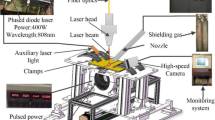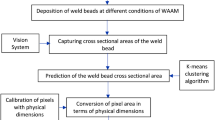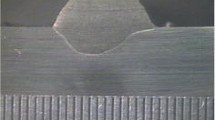Abstract
It is necessary to estimate the weld bead width and depth of penetration using suitable sensors during welding to monitor weld quality. Among the vision sensors, infra red sensing is the natural choice for monitoring welding processes as welding is inherently a thermal processing method. An attempt has been made to estimate the weld bead width and depth of penetration from the infra red thermal image of the weld pool using artificial neural network models during A-TIG welding of 3 mm thick type 316 LN stainless steel plates. Real time infra red images were captured using IR camera for the entire weld length during A-TIG welding at various current values. The image features such as length and width of the hot spot, peak temperature, and other features using line scan analysis are extracted using image processing techniques corresponding to particular locations of the weld joint. These parameters along with their respective current values are used as inputs while the measured weld bead width and depth of penetration are used as output of the neural network models. Accurate ANN models predicting weld bead width (9-11-1) and depth of penetration (9-9-1) have been developed. The correlation coefficient values obtained were 0.98862 and 0.99184 between the measured and predicted values of weld bead width and depth of penetration respectively.
Similar content being viewed by others
References
Andersen K., Cook G. E., Karsai G., Ramaswamy K. (1990) Artificial neural networks applied to arc welding process modelling and control. IEEE Transactions on Industry Applications 26(5): 824–830
Baneerjee, P., Liu, J. Y., & Chin, B. A. (1992). Infrared thermography for non-destructive monitoring of weld penetration variations. In M. Liu (Ed.), Proceedings of the Japan USA symposium on flexible automation (pp. 291–295).
Barry J. M., Paley Z., Adams C. M. Jr. (1963) Heat conduction from moving arc in welding. Welding Journal 42(3): 97-s–104-s
Chan B., Pacey J., Bibby M. (1999) Modeling gas metal arc weld geometry using artificial neural network technology. Canadian Metallurgical Quarterly 38(1): 43–51
Chen W., Chin B. A. (1990) Monitoring joint penetration using infrared sensing techniques. Welding Research Supplement 69: 181s–185s
Dorschu K. E. (1968) Control of cooling rate in steel weld metal. Welding Journal 50(11): 49-s–62-s
Ghanty P., Paul S., Mukherjee D. P., Vasudevan M., Pal N. R., Bhaduri A. K. (2007) Modelling weld bead geometry using neural networks for GTAW of an Austenitic stainless steel. Science and Technology of Welding and Joining 12(7): 649–658
Ghanty P., Vasudevan M., Chandrasekhar N., Mukherjee D., Maduraimuthu V., Pal N. R., Bhaduri A. K., Bharat P., Raj B. (2008) An artificial neural network approach for estimating weld bead width and depth of penetration from infra red thermal image of weld pool. Science and Technology of Welding and Joining 13(4): 395–401
Govardhan, S. M., & Chin, B. A. (1990). Monitoring GTA weld puddle geometry using measured temperature gradients. In S. A. David, & J. M. Vitek (Eds.), Recent trends in welding Science and technology (pp. 383–386).
Houghton M. A., Lucas J. J., Lucas W. (2007) Vision systems for monitoring and control of arc welding operations. Soldagem Inspect Sao Paulo 12(4): 293–299
Kannatey-Asibu J. R. E., Kikuchi N., Jallard A. R. (1989) Experimental finite element analysis of temperature distribution during arc welding. Journal of Engineering Materials and Technology 111: 9–18
Lee J. I., Um K. W. (2000) A prediction of welding process parameters by prediction of back bead geometry. Journal of Materials Processing and Technology 108: 106–113
Malmuth N. D., Hall W. F., Davis B. I., Rosen C. D. (1974) Transient thermal phenomena and weld geometry in GTAW. Welding Journal 53(9): 388–400
Menaka M., Vasudevan M., Venkatraman B., Raj B. (2005) Estimating bead width and depth of penetration during welding by infrared thermal imaging. Journal of British Institute of NDT 47(9): 564–568
Nandhitha N. M., Manoharan N., Sheela rani B., Venkataraman B., Vasudevan M., Kalyana Sundaram P., Raj B. (2009) Prediction of torch current deviation using feed forward neural network for monitoring lack of penetration from thermal images in GTAW of AISI stainless steel 316. International Journal Intelligent Information and Processing 3(2): 271–279
Nagarajan S., Banerjee P., Chen W. H., Chin B. A. (1992) Control of welding process using infrared sensors. IEEE Transactions on Robotics and Automation 8(1): 86–92
Nagarajan P., Banerjee S., Chin B. A. (1990) Thermal imaging for weld quality control in arc welding processes. Transport Phenomena in Materials Processing 146: 171–178
Nagarajan S., Chen W. H., Chin B. A. (1989) Infrared sensing for adaptive arc welding. Welding Research Supplement 68(11): 462-s–466-s
Pietrzak K. A., Packer S. M. (1994) Vision based weld pool width control. ASME Journal of Engineering for Industry 116: 86–92
Rider, G. (1975). Measurement of weld pool size by self-scanned photodiode arrays. In Proceedings IEE international conference on ‘low light and thermal imaging systems (pp. 3–5).
Rider, G. (1983). Control of weld pool size and position for automatic and robotic sensory welding. In Proceedings 3rd international conference on robot vision and sensory controls.
Saeed G., Zhang Y. M. (2007) Weld pool surface depth measurement using a calibrated camera and structured light. Measurement Science and Technology 18: 2570–2578
Sheela rani, B., Nandhitha, N. M., Manoharan, N., Venkataraman, B., Vasudevan, M., Chandrasekar, N., et al. (2008). Euclidean distance based colour image segmentation algorithm for dimensional characterization of lack of penetration from weld thermographs for online weld monitoring in GTAW. In 17th World conference on non-destructive testing.
Smith J. S., Lucas W. (1999) Vision based systems for controlling the arc welding operation and inspecting the weld bead profile. Welding in the World, Supplementary Issue 43: 10–22
Vasudevan, M. (2007). Computational and experimental studies on arc welded austenitic stainless steels. PhD Thesis, Indian Institute of Technology, Chennai.
Vasudevan M., Muruganath M., Bhaduri A. K., Raj B., Prasad Rao K. (2004) Bayesian neural network analysis of ferrite number in stainless steel. Science and Technology of Welding and Joining 9(2): 109–120
Wickle H. C., Chen F., Nagarajan S., Chin B. A. (1998) Survey of infrared sensing techniques for welding process monitoring and control. Journal of Chinese Institute of Engineers 21(6): 645–657
Wikle H. C., Kottilingam S., Zee R. H., Chin B. A. (2001) Infrared sensing techniques for penetration depth control of the submerged arc welding process. Journal of Materials Processing Technology 113: 228–233
Author information
Authors and Affiliations
Corresponding author
Rights and permissions
About this article
Cite this article
Chokkalingham, S., Chandrasekhar, N. & Vasudevan, M. Predicting the depth of penetration and weld bead width from the infra red thermal image of the weld pool using artificial neural network modeling. J Intell Manuf 23, 1995–2001 (2012). https://doi.org/10.1007/s10845-011-0526-4
Received:
Accepted:
Published:
Issue Date:
DOI: https://doi.org/10.1007/s10845-011-0526-4




